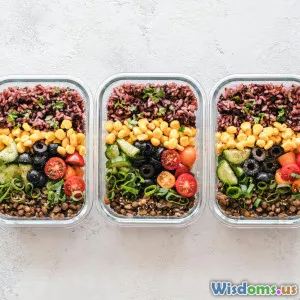
How to Create a Balanced Meal Plan
8 min read Discover how to create a balanced meal plan that fuels your body, optimizes health, and fits your lifestyle. (0 Reviews)
How to Create a Balanced Meal Plan
Creating a balanced meal plan is not just about eating healthy — it’s about fueling your body for optimal energy, well-being, and longevity. Yet in today’s fast-paced world, many people struggle to design meals that provide the right nutrients without complexity. This article dives deep into how to create a balanced meal plan that fits your lifestyle, maximizes nutrition, and helps you feel your best every day.
Understanding the Importance of a Balanced Meal Plan
A balanced meal plan aims to provide all the nutrients your body needs in adequate amounts on a regular basis. Why is this critical? According to the World Health Organization (WHO), insufficient intake of essential nutrients can lead to chronic diseases such as cardiovascular diseases, diabetes, and obesity. A meal plan that balances macronutrients — carbohydrates, proteins, and fats — along with vital micronutrients like vitamins and minerals, supports bodily functions, recovery, and disease prevention.
For example, the Dietary Guidelines for Americans recommend that adults divide their daily calories roughly into 45-65% carbohydrates, 10-35% protein, and 20-35% fats. Crafting meals aligned with this macros ratio while ensuring diversity and quality leads to sustained energy, improved digestion, stable moods, and weight management.
Step 1: Assess Your Dietary Needs
Personalization is key. Your balanced meal plan should reflect your age, gender, activity level, and any specific health conditions.
-
Calculate your calorie needs: Tools like the Harris-Benedict equation or apps such as MyFitnessPal can estimate your total daily energy expenditure (TDEE). For example, a moderately active 30-year-old woman might need around 2,000 calories per day.
-
Consider macro goals: Athletes may require higher protein intake, while those aiming for weight loss might focus on calorie deficits without compromising nutrient diversity.
-
Identify dietary restrictions and preferences: Are you vegetarian, vegan, or have allergies? A balanced plan must accommodate these to be sustainable.
Step 2: Prioritize Nutrient-Dense Foods
Choosing the right ingredients turns a meal plan from good to great.
-
Carbohydrates: Opt for complex carbs found in whole grains (brown rice, quinoa, oats), legumes, vegetables, and fruits. They provide fiber for digestion and have a low glycemic index, helping maintain blood sugar.
-
Proteins: Incorporate lean meats (chicken breast, turkey), fish rich in omega-3 (salmon, mackerel), plant proteins (tofu, lentils, chickpeas), and dairy or dairy alternatives.
-
Fats: Emphasize healthy fats such as those in avocados, nuts, seeds, and olive oil. Avoid trans fats and limit saturated fat.
-
Micronutrients: Aim for a colorful plate. Bell peppers, spinach, carrots, berries, and citrus fruits come packed with vitamins like A, C, and K, as well as minerals such as iron and calcium.
A 2019 study in the American Journal of Clinical Nutrition showed that diets rich in nutrient-dense whole foods consistently contribute to enhanced brain function and reduced inflammation.
Step 3: Plan Meals and Portions
Structure your meals to balance nutrients throughout the day. Here’s a practical framework:
-
Breakfast: Include proteins and fiber-rich carbs (e.g., Greek yogurt with berries and oats). This combination aids concentration and controls appetite.
-
Lunch: Balance lean protein, veggies, and whole grains (e.g., roasted chicken, quinoa salad with mixed greens).
-
Dinner: Light on carbs if desired, emphasize veggies and protein (e.g., steamed fish with broccoli and sweet potato).
-
Snacks: Healthy options like nuts, hummus with carrot sticks, or fruit help maintain energy and prevent overeating later.
For portion control, visual aids can help. For instance, a serving of protein about the size of your palm, half your plate filled with vegetables, and the remaining quarter with whole grains represents balanced proportions.
Step 4: Prepare for Success with Meal Prep Strategies
Practical planning ensures you stick to your balanced meal plan:
-
Weekly shopping list: Base it on meals you plan ahead, buying fresh produce, whole foods, and minimally processed items.
-
Batch cooking: Prepare staples like grilled chicken, roasted vegetables, or grains at once—this saves time and prevents last-minute unhealthy choices.
-
Flexible recipes: Have go-to simple recipes that can mix and match ingredients to keep meals interesting. For example, stir-fries, salads, and wraps.
Step 5: Monitor, Adapt, and Stay Consistent
Nutrition science recommends patience and consistency. Keep a food diary or use digital apps to track eating habits and adjust as you learn what works best.
Professional insights matter. Registered dietitian Lisa Andrews states, “Meal planning should be viewed as an evolving process, attentive to your body’s responses, lifestyle changes, and seasonal availability of foods.”
Additionally, regular check-ins with your health provider help monitor outcomes such as blood markers or energy levels.
Real-World Example: Balanced Meal Plan for a Busy Professional
Maria, a 35-year-old marketing manager who works a fast-paced job and aims to maintain her weight, follows this daily plan:
- Breakfast: Oatmeal topped with walnuts and blueberries, plus a boiled egg.
- Lunch: Quinoa salad with chickpeas, cherry tomatoes, cucumbers, olives, and feta cheese dressed with olive oil.
- Snack: Apple slices with almond butter.
- Dinner: Baked salmon with steamed asparagus and roasted sweet potatoes.
This plan meets macro goals, emphasizes whole foods, and fits Maria’s hectic schedule through bulk-prepared components, showing balanced nutrition need not be complex.
Conclusion
A balanced meal plan is foundational to health and vitality, yet crafting one can feel overwhelming. By assessing needs, focusing on nutrient density, structuring meals thoughtfully, and embracing practical strategies for preparation and flexibility, anyone can design a plan tailored to their life.
The payoff is remarkable: improved energy, better mood, disease prevention, and a deeper connection to your body’s wellbeing. Start with small steps today, and watch how proper fuel transforms your daily performance and health journey.
Remember, balance does not mean perfection — it means nourishing your body consistently and joyfully.
Rate the Post
User Reviews
Popular Posts


















